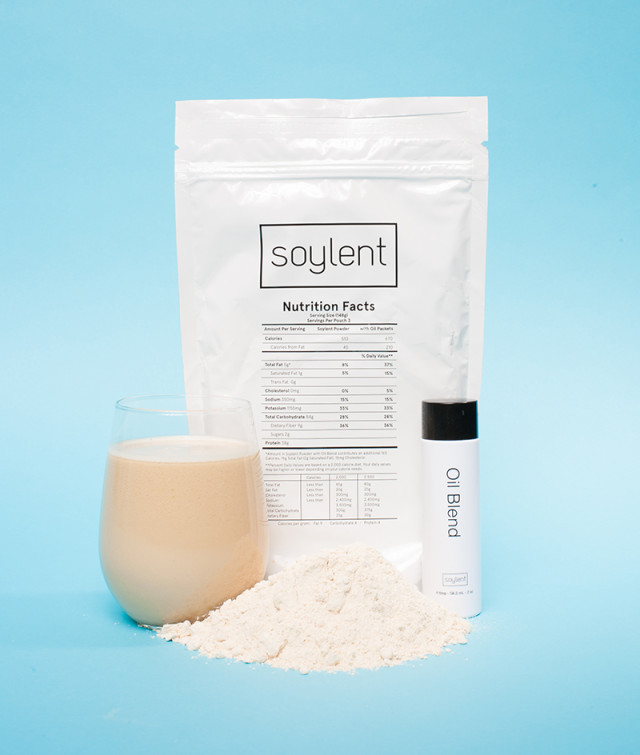Is Soylent the End of Solid Food As We Know It?

I love food—especially breakfast. I could live on Laurelhurst Market chef Benjamin Bettinger’s semolina corn cakes with poached eggs and bacon, and I’d die with a smile on my face the day that much-deserved heart attack struck me down. But since Bettinger isn’t my personal cook, it’s my job to prepare a healthy, balanced breakfast every morning—which takes time and energy, two things I rarely have at 6 am.
Convenience, or the perceived idea of convenience, almost always wins out and I wind up in line at Starbucks, waiting the same amount of time it would’ve taken me to scramble some eggs. I fork over too much money for a three-shot grande latte and a dry, nutritionless scone, cementing my fate to feel like crap for the rest of the day.
The trade off is a hard one: either take time and money to make a balanced meal at home, or opt for the convenience of fast-food, sacrificing nutrition.
This was the dilemma electrical engineer and computer scientist Robert Rhinehart faced every day before finally posing the question: what nutrients does the human body need to remain healthy and function efficiently, and can that be replicated on a chemical level into a meal that’s as easy to prepare as mixing a protein shake?
After rigorous testing using himself as the guinea pig, Rhinehart created Soylent. Currently recognized by the FDA as food—not a food supplement—Soylent is a powder that when mixed with water and a small amount of oil becomes a balanced meal containing all the nutrients, protein, carbohydrates, fats, fiber, vitamins and minerals people need to function. It uses sustainable ingredients, is classified as both Kosher and vegan, doesn’t expire for years, doesn’t need to be refrigerated in its powdered form, and each serving breaks down to about $3 per “meal.”
Each drinkable meal weighs in at about 500-600 calories, and preparation is as easy as adding one cup of water to one scoop of Soylent and mixing it. The oil is optional, and there’s a whole DIY website dedicated to improving or altering Solent’s nutritional values based on personal requirements. Intrigued, I asked a trusted scientist-friend for a sample of her recently acquired Soylent order. (With such high demand for a relatively small production facility, Soylent orders can take months to fulfill, and I wasn’t willing to wait.)
Soylent is all about full disclosure; It lists every ingredient and nutrient percentage in big print on the resealable bag. The powder inside smells like sugar-free vanilla pudding, and has the consistency of the lava dust my chinchilla used to roll around in. The single serving my friend gave me filled up three-quarters of my Magic Bullet cup. I added water and blended it for less than a few seconds, which was all it needed to fully dissolve, reducing the volume by half.
It tastes like unsweetened cookie dough, the texture is noticeably chalky, and it’s laughably the same shade as my liquid foundation—so much for getting rid of the “Soylent is people” references. Convinced such a small serving would never fill me up, I was surprised when three-quarters of the way through, I stopped feeling hungry. I ate my Soylent during lunchtime, when I’m most prone to hovering over the office’s snack table, and it definitely quelled my desire to forage for Oreos. I didn’t notice any energy boost or feeling of healthful euphoria, but I did feel satisfied until the end of the day, and I didn’t have that mid-afternoon food-coma that so many of us fall prey to.
Some people live on Soylent, but most just use it as a healthy replacement for their most time-crunched meals. I could also see it being useful for backpackers as an alternative to dehydrated food, and potentially invaluable for people in countries where food is scarce or contaminated.
Rhinehart sees the product as an ongoing experiment to deliver the most efficient food alternative humanity can ask for, and is constantly reevaluating the formula to provide peak nutrition. Version 1.3 was released in December 2014, and in January Soylent received 20 million dollars of funding, securing Soylent’s future in the food market. It doesn’t taste as good as semolina corn cakes and bacon, but I’d definitely take Soylent over stale scones at Starbucks.
For more information, including a full list of Solent’s ingredients, visit soylent.me.
